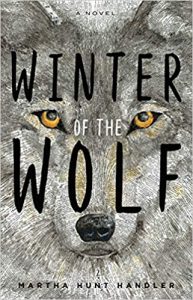My Long and Winding Road to Publication
 It’s been a long and winding road from the time I first started journaling about the sudden death of my best friend’s twelve-year-old son, Brendan, until the day my novel, Winter of the Wolf, was published. “Long” equating to eighteen years, and “winding” because nothing about it was straight forward.
It’s been a long and winding road from the time I first started journaling about the sudden death of my best friend’s twelve-year-old son, Brendan, until the day my novel, Winter of the Wolf, was published. “Long” equating to eighteen years, and “winding” because nothing about it was straight forward.
At the time of Brendan’s death, I was 42 and not a writer. I’d always been a nature girl and had enjoyed writing nature stories from an early age, however, my father had cautioned that “fiction writing doesn’t pay bills.” So, instead, I wrote scientific papers as an environmental consultant. But the work never felt particularly satisfying. When I become pregnant with our first child, I took time off to consider a career change. Four kids later, I still had no answers.
When Brendan passed, and it totally rocked my world. The thought of losing a child was horrifying, and I couldn’t find adequate words to comfort Brendan’s mom. We were both very spiritual and believed souls, being energy, never die, but that didn’t provide much solace. To sort through my conflicted and confusing feelings, I began to journal ferociously.
A few months later, I began to hear Brendan’s voice. He insisted that writing was my true calling and that my journal entries were the beginning of a novel. Though I’d never before channeled anyone, his voice was loud, clear, and unrelenting. I didn’t know exactly where I was going or even why, but I wrote every free minute I could find. For my protagonist, I chose a woman enrolled in an MFA program who was failing because she’d never fully recovered from the death of her when they were both children.
For the next twelve years, I worked on my novel sporadically, due to the demands of raising four kids, and secretively, because I was so unsure of my writing talent. When our kids had all grown and flown, I knew the time had come for me to finally get serious, so I splurged on an office and came clean to my family and friends. Two years later, at the age of 55, my first draft was complete. It was much too long (136,000 pages), but I had no idea how to edit it, and, honestly, I just wanted to launch it – out the window if need be!
After some research, I sent it to 8 agents, who all quickly rejected it. However, two wrote notes suggesting that rather than having an adult who’s looking back on her brother’s death, I should keep her young and let it unfold in real-time to help build tension. What they were saying was that I should scrap my novel and start from scratch. No way, I thought. After letting the idea percolate for a few months, I concluded that they were right.
Since a 28-year-old sounds nothing like a 15-year-old, I had to find a new voice. I spent nine months strictly reading YA books, which I found surprisingly smart and real, compared to what I’d grown up reading. Eventually, I discovered my protagonist’s voice, and I was off and running. But this YA version was much more challenging because my protagonist, Bean was living every day in her pain and loss, which means I was also.
Within a year, I had this next draft completed; however, it was too long once again. Lamenting on this issue with a friend, she asked if I’d considered using a book coach. I’d never heard of one, but I did some research and finally chose Jenny Nash. She let me know she was no-nonsense from the get-go, and I’d have to adhere to me strict deadlines. My first assignment was to write a paragraph explaining why I was writing the novel.
This was a game-changer, as I realized I wasn’t writing a frivolous novel; I had a purpose. I wanted my book to help readers transition from grief to gratitude, think about how we treat suicides, fully embrace their intuition, reconnect with nature, and be less judgmental. My “why” paragraph immensely hastened my editing process, as it allowed me to see that I needed to cut everything not aligned with my message. Editing was still painful, but as Jennie kept reminding me, “Keep your edits in a file. Maybe you’ll use them in a future novel.”
My next assignment was to write a chapter outline. Each chapter had to have a presenting issue/dilemma, a resolution, and lastly, another issue/dilemma that would propel the reader to the next chapter. Between the paragraph and the outline, I had my manuscript down to 30,000 words in less than five months.
I was happy with the finished product and super optimistic that I’d quickly find an agent. After completing my research and extensive networking, I sent it to fifteen agents, all of whom promptly rejected it. Feeling utterly despondent, I went to hear a literary agent speak about publishing options. I knew the standard route and about self-publishing, though I’d never heard of hybrid publishers. The next day, just as I was poised to email Jenny asking why she’d never mentioned this option, she emailed asking if she could pass on my novel to a hybrid publishing house. The rest, as they say, is history.
Although my writing journey was long and winding, I see now that I needed this time to grow as a writer and grow into my message. And my messages are more relevant today than they would have been two decades ago.
—
Martha Hunt Handler grew up in northern Illinois dreaming about wolves and has always understood that her role in this lifetime is to tell stories and be a voice for nature. She has been an environmental consultant, a magazine columnist, an actress, and a polar explorer, among other occupations. She has also driven across the country in an 18-wheeler and been a grand-prize winner of The Newlywed Game.
Soon after she and her family relocated from Los Angeles to South Salem, New York, she began to hear wolves in her backyard. This was the start of her twenty-plus-year career as an advocate for wolves at the Wolf Conservation Center, where she currently serves as Board President. When not up near the wolves and her rescue pups, she can be found in New York City with her husband and four adult children.
This is her first novel but definitely not her last.
WINTER OF THE WOLF, Martha Hunt Handler
A tragic mystery blending sleuthing and spirituality

Winter Of The Wolf, Martha Hunt Handler
An exploration in grief, suicide, spiritualism, and Inuit culture, Winter of the Wolf follows Bean, an empathic and spiritually evolved fifteen-year-old, who is determined to unravel the mystery of her brother Sam’s death. Though all evidence points to a suicide, her heart and intuition compel her to dig deeper.
With help from her friend Julie, they retrace Sam’s steps, delve into his Inuit beliefs, and reconnect with their spiritual beliefs to uncover clues beyond material understanding.
Both tragic and heartwarming, this twisting novel draws you into Bean’s world as she struggles with grief, navigates high school dramas, and learns to open her heart in order to see the true nature of the people around her. Winter of the Wolf is about seeking the truth—no matter how painful—in order to see the full picture.
In this novel, environmentalist and award-winning author, Martha Handler, brings together two important pieces of her life—the death of her best friend’s son and her work as president of the Wolf Conservation Center—to tell an empathetic and powerful story with undeniable messages.
“Winter of the Wolf is a compelling, heartfelt tale based on a story close to the author’s heart. She takes what is a difficult subject and weaves a captivating story about life, death, grief, and gratitude. A must-read for any age.”
–Mary Ellen Keating, former Senior Vice President of Communications for Barnes & Noble, Inc.
Category: Contemporary Women Writers, How To and Tips






















